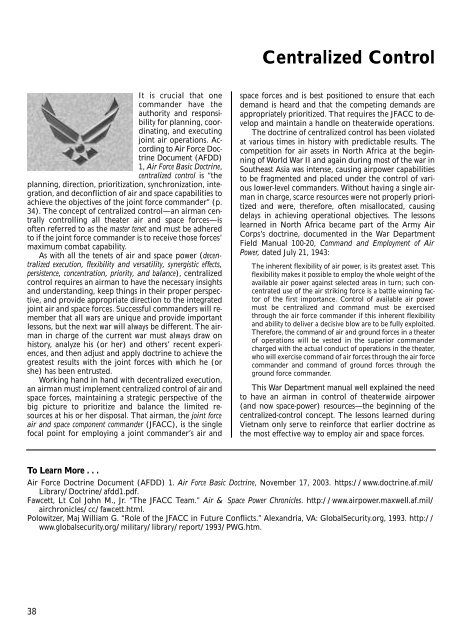presentation departments reproduced
Spring 2004 - Air and Space Power Journal - Air Force Link
Spring 2004 - Air and Space Power Journal - Air Force Link
- No tags were found...
Create successful ePaper yourself
Turn your PDF publications into a flip-book with our unique Google optimized e-Paper software.
Centralized Control<br />
It is crucial that one<br />
commander have the<br />
authority and responsibility<br />
for planning, coordinating,<br />
and executing<br />
joint air operations. According<br />
to Air Force Doctrine<br />
Document (AFDD)<br />
1, Air Force Basic Doctrine,<br />
centralized control is “the<br />
planning, direction, prioritization, synchronization, integration,<br />
and deconfliction of air and space capabilities to<br />
achieve the objectives of the joint force commander” (p.<br />
34). The concept of centralized control—an airman centrally<br />
controlling all theater air and space forces—is<br />
often referred to as the master tenet and must be adhered<br />
to if the joint force commander is to receive those forces’<br />
maximum combat capability.<br />
As with all the tenets of air and space power (decentralized<br />
execution, flexibility and versatility, synergistic effects,<br />
persistence, concentration, priority, and balance), centralized<br />
control requires an airman to have the necessary insights<br />
and understanding, keep things in their proper perspective,<br />
and provide appropriate direction to the integrated<br />
joint air and space forces. Successful commanders will remember<br />
that all wars are unique and provide important<br />
lessons, but the next war will always be different. The airman<br />
in charge of the current war must always draw on<br />
history, analyze his (or her) and others’ recent experiences,<br />
and then adjust and apply doctrine to achieve the<br />
greatest results with the joint forces with which he (or<br />
she) has been entrusted.<br />
Working hand in hand with decentralized execution,<br />
an airman must implement centralized control of air and<br />
space forces, maintaining a strategic perspective of the<br />
big picture to prioritize and balance the limited resources<br />
at his or her disposal. That airman, the joint force<br />
air and space component commander (JFACC), is the single<br />
focal point for employing a joint commander’s air and<br />
space forces and is best positioned to ensure that each<br />
demand is heard and that the competing demands are<br />
appropriately prioritized. That requires the JFACC to develop<br />
and maintain a handle on theaterwide operations.<br />
The doctrine of centralized control has been violated<br />
at various times in history with predictable results. The<br />
competition for air assets in North Africa at the beginning<br />
of World War II and again during most of the war in<br />
Southeast Asia was intense, causing airpower capabilities<br />
to be fragmented and placed under the control of various<br />
lower-level commanders. Without having a single airman<br />
in charge, scarce resources were not properly prioritized<br />
and were, therefore, often misallocated, causing<br />
delays in achieving operational objectives. The lessons<br />
learned in North Africa became part of the Army Air<br />
Corps’s doctrine, documented in the War Department<br />
Field Manual 100-20, Command and Employment of Air<br />
Power, dated July 21, 1943:<br />
The inherent flexibility of air power, is its greatest asset. This<br />
flexibility makes it possible to employ the whole weight of the<br />
available air power against selected areas in turn; such concentrated<br />
use of the air striking force is a battle winning factor<br />
of the first importance. Control of available air power<br />
must be centralized and command must be exercised<br />
through the air force commander if this inherent flexibility<br />
and ability to deliver a decisive blow are to be fully exploited.<br />
Therefore, the command of air and ground forces in a theater<br />
of operations will be vested in the superior commander<br />
charged with the actual conduct of operations in the theater,<br />
who will exercise command of air forces through the air force<br />
commander and command of ground forces through the<br />
ground force commander.<br />
This War Department manual well explained the need<br />
to have an airman in control of theaterwide airpower<br />
(and now space-power) resources—the beginning of the<br />
centralized-control concept. The lessons learned during<br />
Vietnam only serve to reinforce that earlier doctrine as<br />
the most effective way to employ air and space forces.<br />
To Learn More . . .<br />
Air Force Doctrine Document (AFDD) 1. Air Force Basic Doctrine, November 17, 2003. https://www.doctrine.af.mil/<br />
Library/Doctrine/afdd1.pdf.<br />
Fawcett, Lt Col John M., Jr. “The JFACC Team.” Air & Space Power Chronicles. http://www.airpower.maxwell.af.mil/<br />
airchronicles/cc/fawcett.html.<br />
Polowitzer, Maj William G. “Role of the JFACC in Future Conflicts.” Alexandria, VA: GlobalSecurity.org, 1993. http://<br />
www.globalsecurity.org/military/library/report/1993/PWG.htm.<br />
38
















